Comparative Simulation of Various Agricultural Land Use Practices for Analysis of Impacts on Environments
Abstract
:1. Introduction
- Universal character of the simulation algorithm, e.g., structural identity of the models for different crop/species, climate-soil conditions and crop growth technologies.
- Comprehensive sequence analysis. The model should consider the influence of crop/species predecessors in all essential aspects such as symbiotic nitrogen fixation by legumes, changes in the agro-chemical and the agro-physical soil properties under tillage, decomposition of crop residues, etc. [21].
- Wintering imitation. The model during simulation should take into account abiotic processes in the agro-ecosystem, such as snowfall, soil frost penetration and thawing, snow melting in off-seasons period, etc.
- Ecological/environmental orientation. The modeling capacities should include not only yield estimation but the forecast of dynamics of various agro-ecosystem sustainability parameters such as (1) energy-matter balance in the agro-landscape including emission of greenhouse gases; (2) nutrition substance transfer to water body; (3) soil carbon sequestration; and (4) humus content (fertility indexes).
2. Materials and Methods
2.1. Model AGROTOOL
- Leningrad region (North-West of Russia): Spring barley, summer wheat, winter rye, oat, potato, perennial grasses.
- Saratov region (middle Volga): Summer wheat in long-term water stress field experiment.
- Krasnodar region (South-West of Russia): Summer wheat, maize.
- Altai region (West Siberia): Alfalfa, summer wheat.
- Kaliningrad region (The most Western region of Russia): Summer wheat, perennial grasses.
- Tver’ region (Central region of Russia): Summer wheat, spring barley, perennial grasses, rape, potato, oat. Landscape field has been tested as well.
2.2. Multivariate Analysis in “APEX”: Integrated Software Environment for Crop Models
2.3. Long-Term Analysis of Different Crop Rotations
- Improving the accuracy and adequacy of simulation in multifactor settings;
- Multivariable computation (e.g., weather vs. climate);
- Statistical interpretation of simulation results and risk analysis;
- Large number of model controlled/monitored characteristics such as productivity, physiology, ecology, fertility, etc.;
- Management of model uncertainties;
- Simulation of several consequent vegetation periods according to a chosen rotation scheme;
- The model must simulate different cultures and take into consideration agroecosystem dynamics during non-growing season (wintering);
- The runtime framework must support the calculation of scenarios in a predetermined sequence and the transfer of data from the previous scenario to the next one.
- mechanism for the direct specification of the execution sequence inside scenarios in the APEX project and to specify “boundary condition” scenarios, defining the beginning of the new crop rotation block for a particular agricultural field;
- An adequate interface/method for the transfer of the results of the previous scenario into the next scenario as initial state. This method must take into account previous crop on agricultural field in the procedure of the metadata specification describing the connected model.
- Shoot litter (aboveground biomass);
- Root litter (belowground biomass);
- Humus content in 1 m layer;
- Total Mineral Nitrogen in 1 m layer;
- Nodule Nitrogen (for legumes).
3. Results and Discussion
4. Conclusions
Acknowledgments
Author Contributions
Conflicts of Interest
References
- Belcher, K.W.; Boehm, M.M.; Fulton, M.E. Agroecosystem sustainability: A system simulation model approach. Agric. Syst. 2004, 79, 225–241. [Google Scholar] [CrossRef]
- Costanzo, A.; Bàrberi, P. Functional agrobiodiversity and agroecosystem services in sustainable wheat production. A review. Agron. Sustain. Dev. 2014, 34, 327–348. [Google Scholar] [CrossRef]
- Badenko, V.; Terleev, V.; Topaj, A. AGROTOOL software as an intellectual core of decision support systems in computer aided agriculture. Appl. Mech. Mater. 2014, 635, 1688–1691. [Google Scholar] [CrossRef]
- Badenko, V.L.; Topaj, A.G.; Yakushev, V.V.; Mirschel, W.; Nendel, C. Crop models as research and interpretative tools. Sel’skokhozyaistvennaya Biol. 2017, 52, 437–445. [Google Scholar] [CrossRef]
- Medvedev, S.; Topaj, A. Crop simulation model registrator and polyvariant analysis. IFIP Adv. Inf. Commun. Technol. 2011, 359, 295–301. [Google Scholar] [CrossRef]
- Wenkel, K.O.; Berg, M.; Mirschel, W.; Wieland, R.; Nendel, C.; Köstner, B. LandCaRe DSS—An interactive decision support system for climate change impact assessment and the analysis of potential agricultural land use adaptation strategies. J. Environ. Manag. 2013, 127, 168–183. [Google Scholar] [CrossRef] [PubMed]
- Dury, J.; Schaller, N.; Garcia, F.; Reynaud, A.; Bergez, J.E. Models to support cropping plan and crop rotation decisions. A review. Agron. Sustain. Dev. 2012, 32, 567–580. [Google Scholar] [CrossRef]
- Welfle, A.; Gilbert, P.; Thornley, P.; Stephenson, A. Generating low-carbon heat from biomass: Life cycle assessment of bioenergy scenarios. J. Clean. Prod. 2017, 149, 448–460. [Google Scholar] [CrossRef]
- Zhao, Z.; Qin, X.; Wang, E.; Carberry, P.; Zhang, Y.; Zhou, S.; Zhang, X.; Hu, C.; Wang, Z. Modelling to increase the eco-efficiency of a wheat-maize double cropping system. Agric. Ecosyst. Environ. 2015, 210, 36–46. [Google Scholar] [CrossRef]
- Tully, K.; Ryals, R. Nutrient cycling in agroecosystems: Balancing food and environmental objectives. Agroecol. Sustain. Food 2017, 41, 761–798. [Google Scholar] [CrossRef]
- Medvedev, S.; Topaj, A.; Badenko, V.; Terleev, V. Medium-term analysis of agroecosystem sustainability under different land use practices by means of dynamic crop simulation. IFIP Adv. Inf. Commun. Technol. 2015, 448, 252–261. [Google Scholar] [CrossRef]
- Acevedo, M.F. Interdisciplinary progress in food production, food security and environment research. Environ. Conserv. 2011, 38, 151–171. [Google Scholar] [CrossRef]
- Capalbo, S.M.; Antle, J.M.; Seavert, C. Next generation data systems and knowledge products to support agricultural producers and science-based policy decision making. Agric. Syst. 2017, 155, 191–199. [Google Scholar] [CrossRef] [PubMed]
- Jones, J.W.; Antle, J.M.; Basso, B.; Boote, K.J.; Conant, R.T.; Foster, I.; Godfray, H.C.J.; Herrero, M.; Howitt, R.E.; Janssen, S.; et al. Brief history of agricultural systems modeling. Agric. Syst. 2017, 155, 240–254. [Google Scholar] [CrossRef] [PubMed]
- Wieland, R.; Mirschel, W.; Nendel, C.; Specka, X. Dynamic fuzzy models in agroecosystem modeling. Environ. Model. Softw. 2013, 46, 44–49. [Google Scholar] [CrossRef]
- Tonitto, C.; Li, C.; Seidel, R.; Drinkwater, L. Application of the DNDC model to the Rodale Institute Farming Systems Trial: Challenges for the validation of drainage and nitrate leaching in agroecosystem models. Nutr. Cycl. Agroecosyst. 2010, 87, 483–494. [Google Scholar] [CrossRef]
- Yu, C.; Li, C.; Xin, Q.; Chen, H.; Zhang, J.; Zhang, F.; Li, X.; Clinton, N.; Huang, X.; Yue, Y.; et al. Dynamic assessment of the impact of drought on agricultural yield and scale-dependent return periods over large geographic regions. Environ. Model. Softw. 2014, 62, 454–464. [Google Scholar] [CrossRef]
- Sun, S.; Delgado, M.S.; Sesmero, J.P. Dynamic adjustment in agricultural practices to economic incentives aiming to decrease fertilizer application. J. Environ. Manag. 2016, 177, 192–201. [Google Scholar] [CrossRef] [PubMed]
- Tan, J.; Cui, Y.; Luo, Y. Global sensitivity analysis of outputs over rice-growth process in ORYZA model. Environ. Model. Softw. 2016, 83, 36–46. [Google Scholar] [CrossRef]
- Rodriguez, D.; de Voil, P.; Rufino, M.C.; Odendo, M.; van Wijk, M.T. To mulch or to munch? Big modelling of big data. Agric. Syst. 2017, 153, 32–42. [Google Scholar] [CrossRef]
- Davari, M.R.; Sharma, S.N.; Mirzakhani, M. Effect of cropping systems and crop residue incorporation on production and properties of soil in an organic agroecosystem. Biol. Agric. Hortic. 2012, 28, 206–222. [Google Scholar] [CrossRef]
- Guillem, E.E.; Murray-Rust, D.; Robinson, D.T.; Barnes, A.; Rounsevell, M.D.A. Modelling farmer decision-making to anticipate tradeoffs between provisioning ecosystem services and biodiversity. Agric. Syst. 2015, 137, 12–23. [Google Scholar] [CrossRef]
- Ozturk, I.; Sharif, B.; Baby, S.; Jabloun, M.; Olesen, J.E. The long-Term effect of climate change on productivity of winter wheat in Denmark: A scenario analysis using three crop models. J. Agric. Sci. 2017, 55, 733–750. [Google Scholar] [CrossRef]
- Jones, J.; Hoogenboom, G.; Porter, C.; Boote, K.; Batchelor, W.; Hunt, L.; Ritchie, J. The DSSAT cropping system model. Eur. J. Agron. 2003, 18, 235–265. [Google Scholar] [CrossRef]
- Sarkar, R.; Kar, S. Sequence Analysis of DSSAT to Select Optimum Strategy of Crop Residue and Nitrogen for Sustainable Rice-Wheat Rotation. Agron. J. 2008, 100, 87–97. [Google Scholar] [CrossRef]
- Li, Z.T.; Yang, J.Y.; Drury, C.F.; Hoogenboom, G. Evaluation of the DSSAT-CSM for simulating yield and soil organic C and N of a long-term maize and wheat rotation experiment in the Loess Plateau of Northwestern China. Agric. Syst. 2015, 135, 90–104. [Google Scholar] [CrossRef]
- Salmerón, M.; Cavero, J.; Isla, R.; Porter, C.H.; Jones, J.W.; Boote, K.J. DSSAT nitrogen cycle simulation of cover crop-maize rotations under irrigated mediterranean conditions. Agron. J. 2014, 106, 1283–1296. [Google Scholar] [CrossRef]
- Köstner, B.; Wenkel, K.-O.; Berg, M.; Bernhofer, C.; Gömann, H.; Weigel, H.-J. Integrating regional climatology, ecology, and agronomy for impact analysis and climate change adaptation of German agriculture: An introduction to the LandCaRe2020 project. Eur. J. Agron. 2014, 52, 1–10. [Google Scholar] [CrossRef]
- Badenko, V.; Kurtener, D.; Yakushev, V.; Torbert, A.; Badenko, G. Evaluation of Current State of Agricultural Land Using Problem-Oriented Fuzzy Indicators in GIS Environment. In International Conference on Computational Science and Its Applications, ICCSA 2016: Computational Science and Its Applications—ICCSA 2016; Springer: Cham, Switzerland, 2016; Volume 9788, pp. 57–69. [Google Scholar]
- De Wit, C.T.; van Keulen, H. Modelling production of field crops and its requirements. Geoderma 1987, 40, 253–265. [Google Scholar] [CrossRef]
- Boote, K.J.; Jones, J.W.; White, J.W.; Asseng, S.; Lizaso, J.I. Putting mechanisms into crop production models. Plant Cell Environ. 2013, 36, 1658–1672. [Google Scholar] [CrossRef] [PubMed]
- Terleev, V.V.; Mirschel, W.; Badenko, V.L.; Guseva, I.Y. An Improved Mualem–Van Genuchten Method and Its Verification Using Data on Beit Netofa Clay. Eurasian Soil Sci. 2017, 50, 445–455. [Google Scholar] [CrossRef]
- Terleev, V.V.; Topaj, A.G.; Mirschel, W. The improved estimation for the effective supply of productive moisture considering the hysteresis of soil water-retention capacity. Russ. Meteorol. Hydrol. 2015, 40, 278–285. [Google Scholar] [CrossRef]
- Richarsdon, C.W.; Wright, D.A. WGEN: A Model for Generating Daily Weather Variables. 1984. Available online: https://www.goldsim.com/Downloads/Library/Models/Applications/Hydrology/WGEN.pdf (accessed on 7 November 2017).
- Fick, S.E.; Hijmans, R.J. WorldClim 2: New 1-km spatial resolution climate surfaces for global land areas. Int. J. Climatol. 2017, 37, 4302–4315. [Google Scholar] [CrossRef]


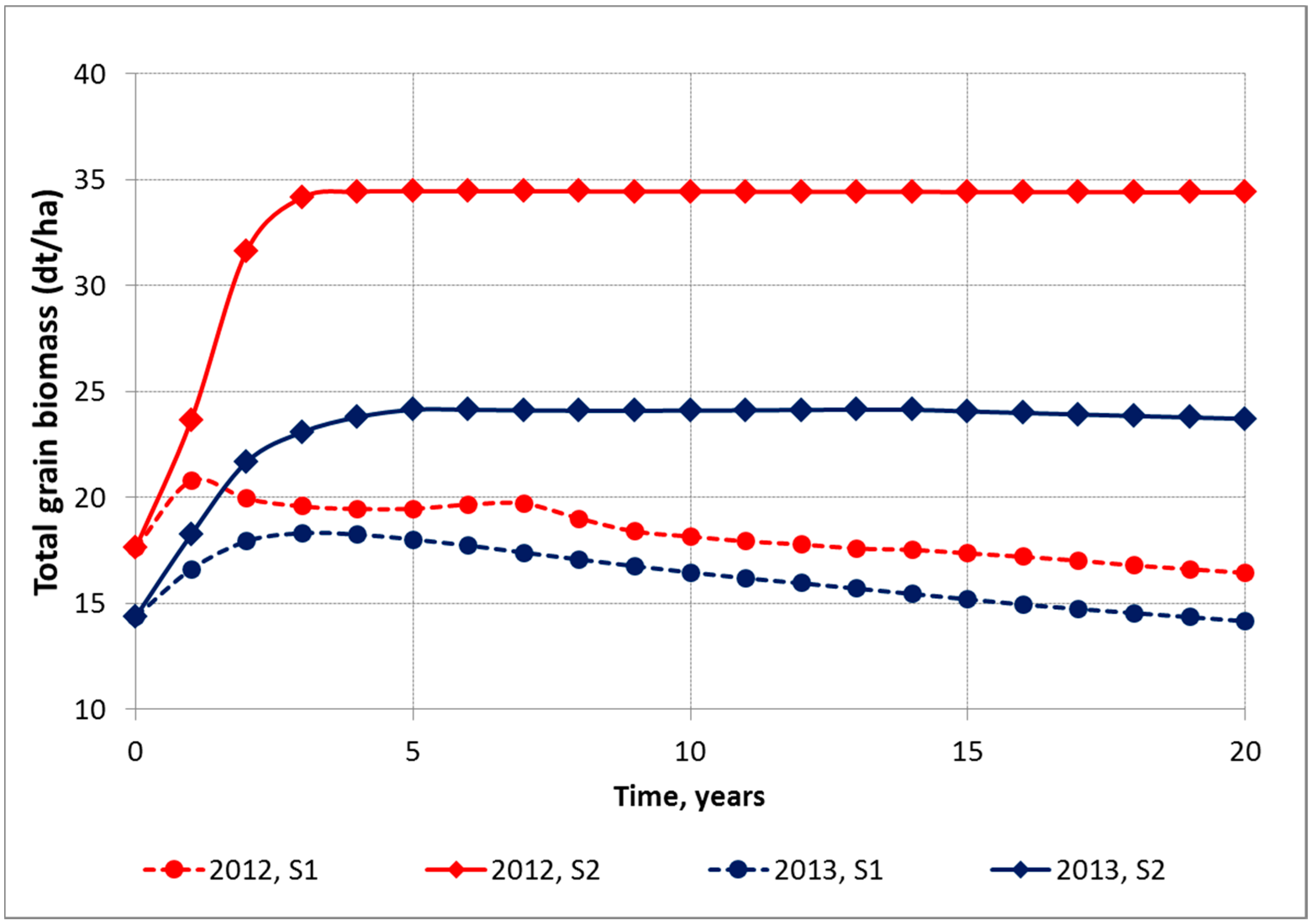
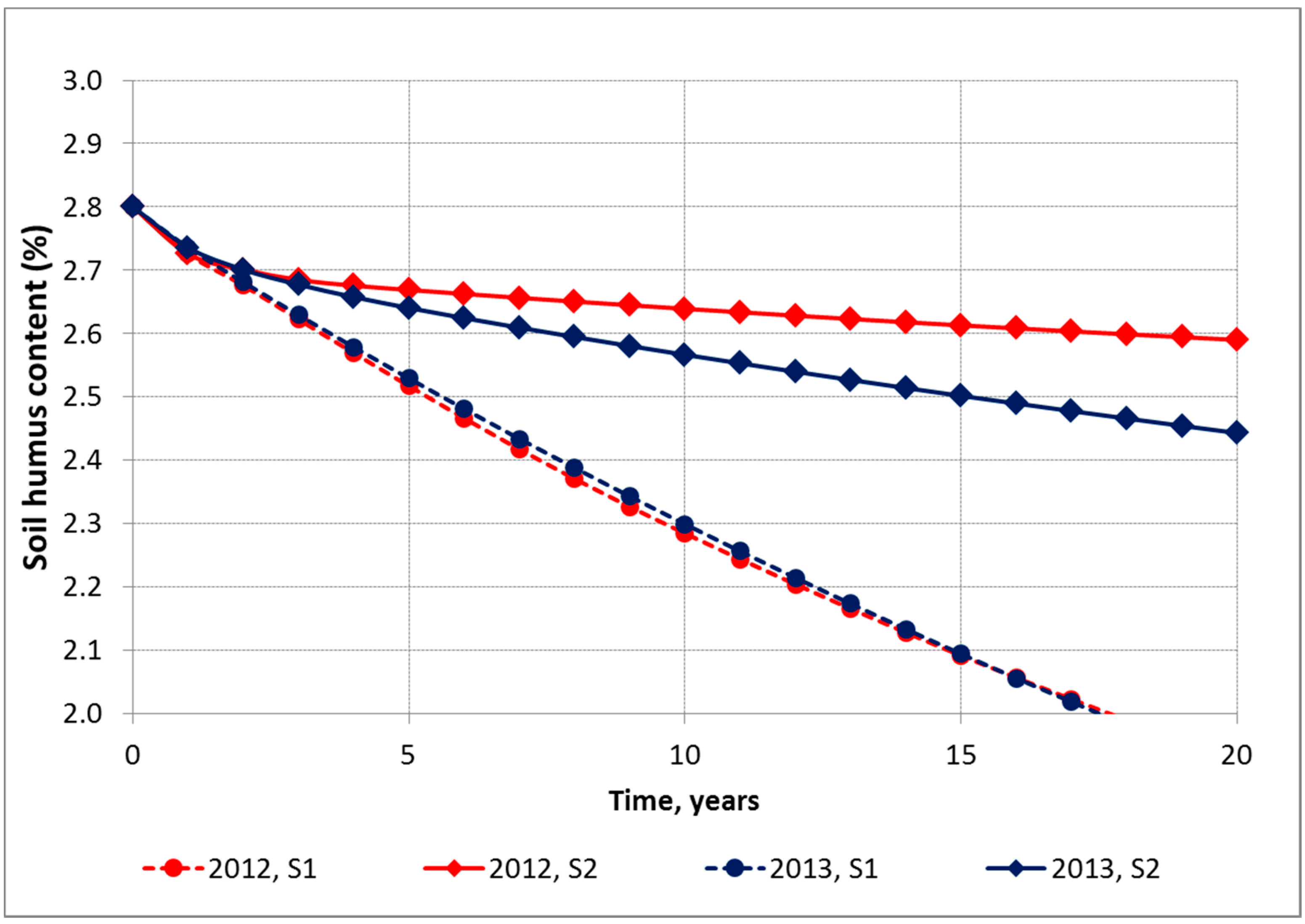
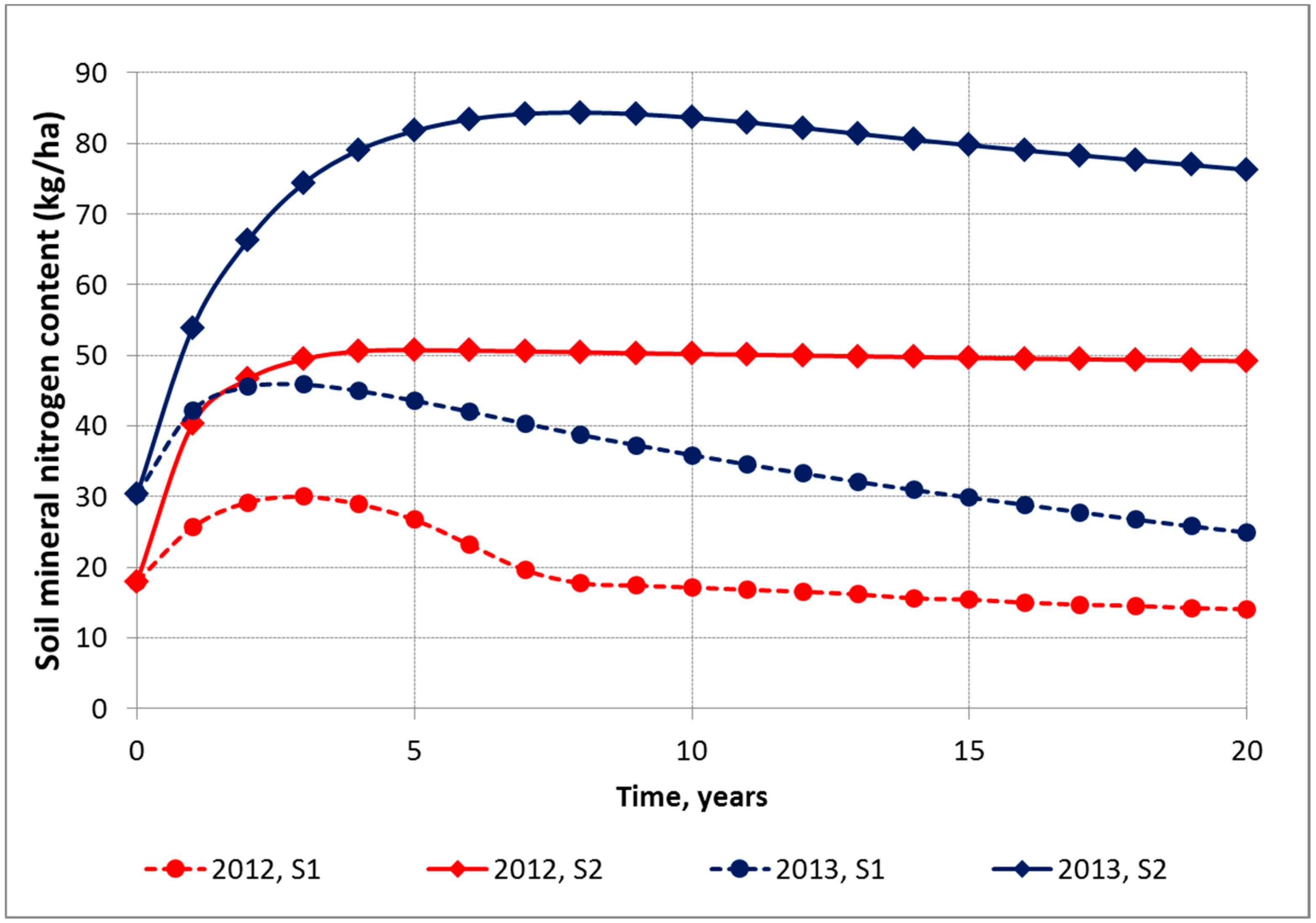



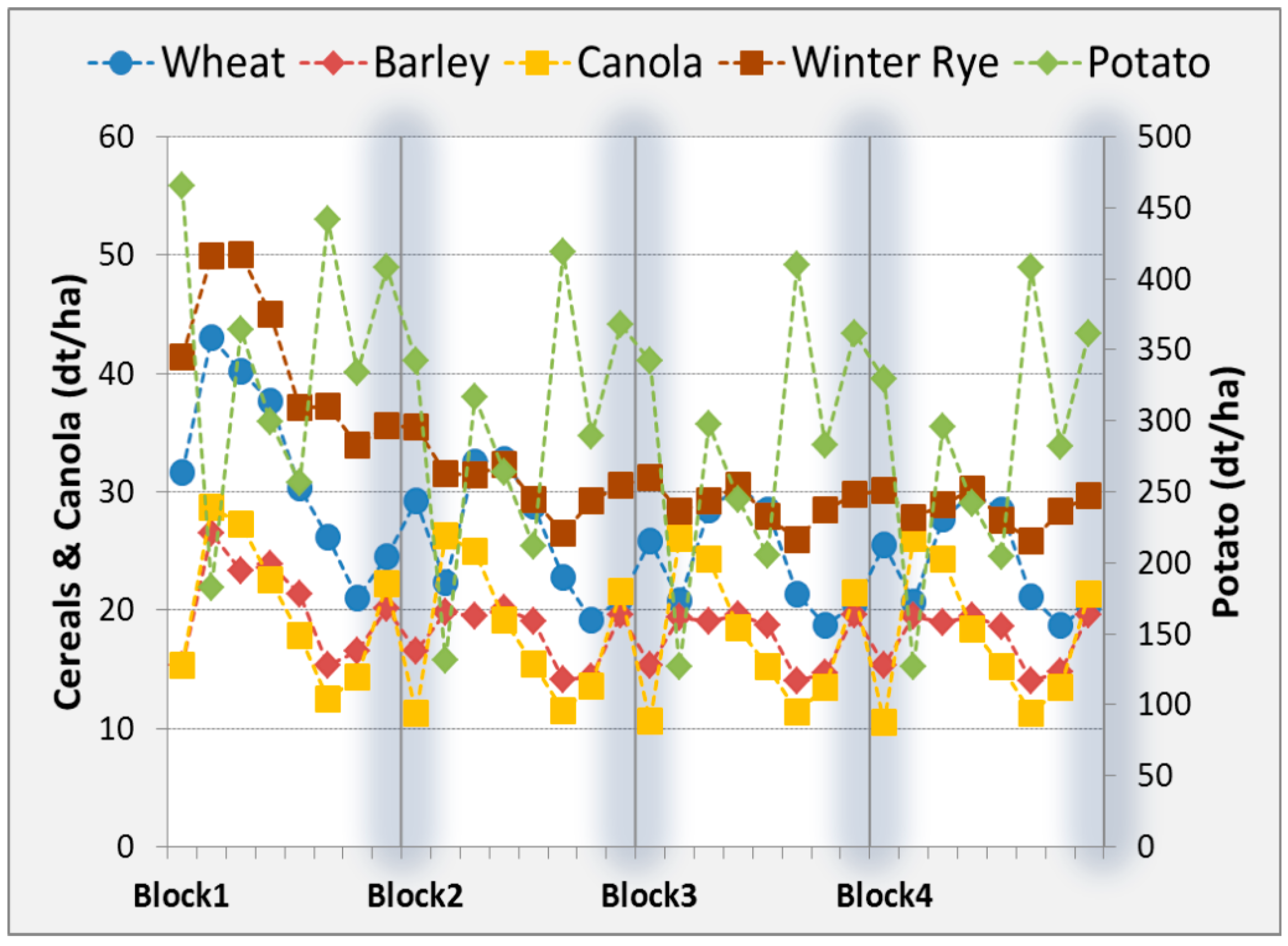
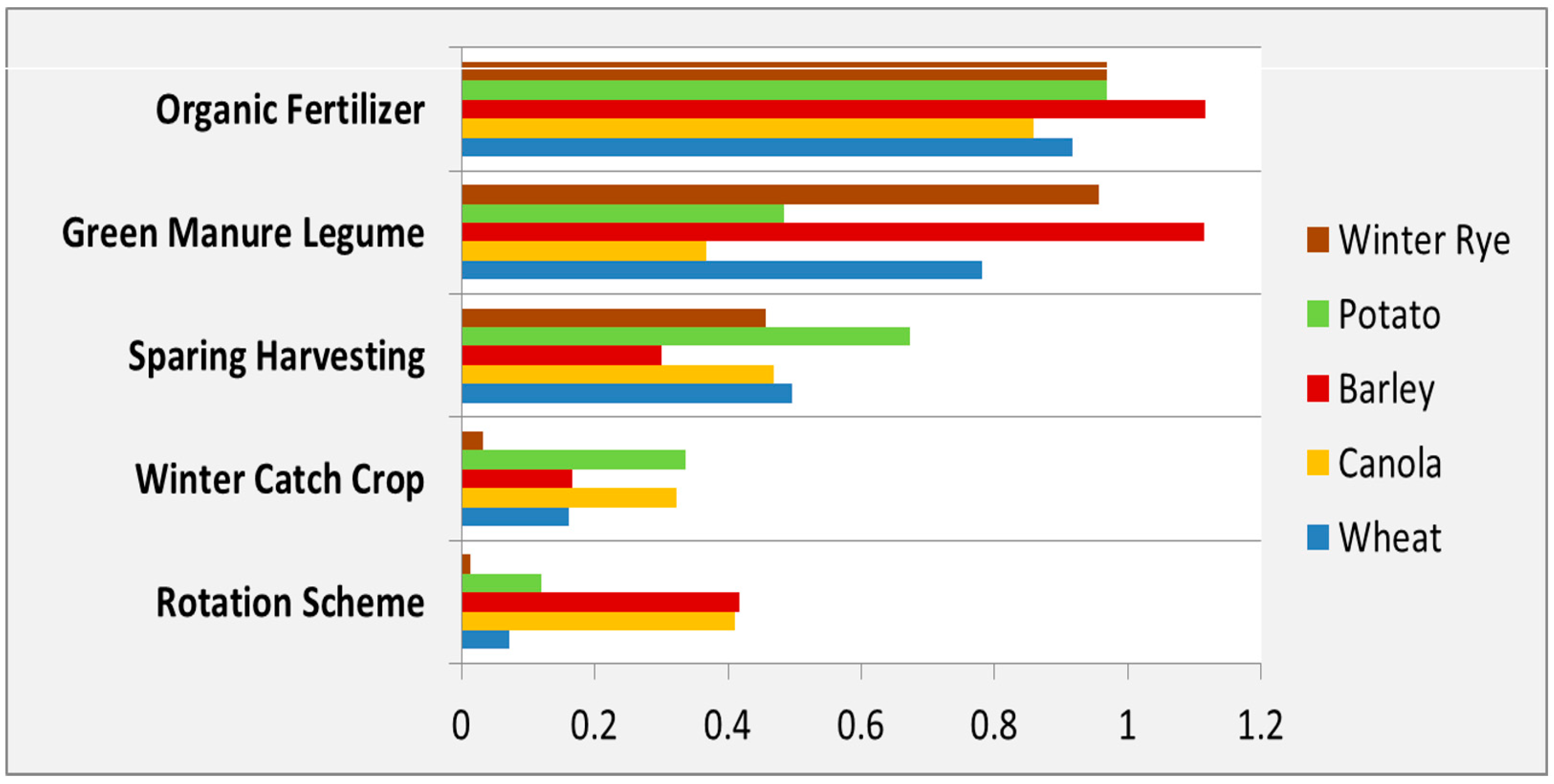

| Modeling Domain | Approach |
|---|---|
| Leaf Area Development & Light Interception | Detailed model based on Monsi-Saeki approach |
| Light Utilization | Original model of photosynthesis as well dark metabolism |
| Yield Formation | Y(PRT)—Partitioning during reproductive stages |
| Crop Phenology | f(Temperature, Water) |
| Root Distribution over Depth | Exponential, based on water availability |
| Stresses Involved | W, N |
| Water Dynamics | Richards equation in 10-layer soil profile |
| Evapotranspiration | Modified FAO56 approach |
| Soil CN-model | C-N transfer and interaction in plant and soil, 5 organic pools |
| Problem | Source of Multivariance |
|---|---|
| Sensitivity analysis and parametric identification | Parameter value variability |
| Statistical analysis and productivity assessment | Actual weather |
| Climate change influence on crop productivity | Future weather scenarios |
| Optimization of agrotechnologies | Variants (dates and rates) of technological treatments |
| Operative information support of field experiments | Variants of technological treatments and future weather to the end of vegetation period |
| Precision agriculture and GIS integration | Spatial heterogeneity of agricultural field |
| Long-term analysis of crop rotation | Fields, seasons, and cultures of rotation under investigation |
| Requirement | Current State |
|---|---|
| Crop Model: | AGROTOOL: |
| Generic simulator | Versatile algorithm for all maintained cultures. Calibrated models for cereals (summer and winter wheat, winter rye, barley, oats), maize, potato, root vegetables, annual and perennial forages, legumes. |
| Uninterrupted runs | Separated calculation of litter and root residues in the module of carbon-nitrogen transfer and transformation in soil. Sub-model of symbiotic nitrogen fixation and nodule nitrogen dynamics. |
| “Wintering” | Snow coverage and snow melting sub-models. |
| Simulation infrastructure: | APEX (Automation of Polivariant Experiments): |
| Multiple running | Validated and implemented integrated environment for multivariate analysis and automation of computer experiments with crop models. |
| Crop rotation support | Special plug-in for planning not full factorial experiments and performing complex serial-parallel schemes of scenario computation. Transfer of “inheritable” variables from the results of previous run to the initial state of the next run inside of the rotation cycle. |
| Forecasting | Built-in stochastic generator of daily weather variables |
© 2017 by the authors. Licensee MDPI, Basel, Switzerland. This article is an open access article distributed under the terms and conditions of the Creative Commons Attribution (CC BY) license (http://creativecommons.org/licenses/by/4.0/).
Share and Cite
Badenko, V.; Badenko, G.; Topaj, A.; Medvedev, S.; Zakharova, E.; Terleev, V. Comparative Simulation of Various Agricultural Land Use Practices for Analysis of Impacts on Environments. Environments 2017, 4, 92. https://doi.org/10.3390/environments4040092
Badenko V, Badenko G, Topaj A, Medvedev S, Zakharova E, Terleev V. Comparative Simulation of Various Agricultural Land Use Practices for Analysis of Impacts on Environments. Environments. 2017; 4(4):92. https://doi.org/10.3390/environments4040092
Chicago/Turabian StyleBadenko, Vladimir, Galina Badenko, Alex Topaj, Sergey Medvedev, Elena Zakharova, and Vitaly Terleev. 2017. "Comparative Simulation of Various Agricultural Land Use Practices for Analysis of Impacts on Environments" Environments 4, no. 4: 92. https://doi.org/10.3390/environments4040092





